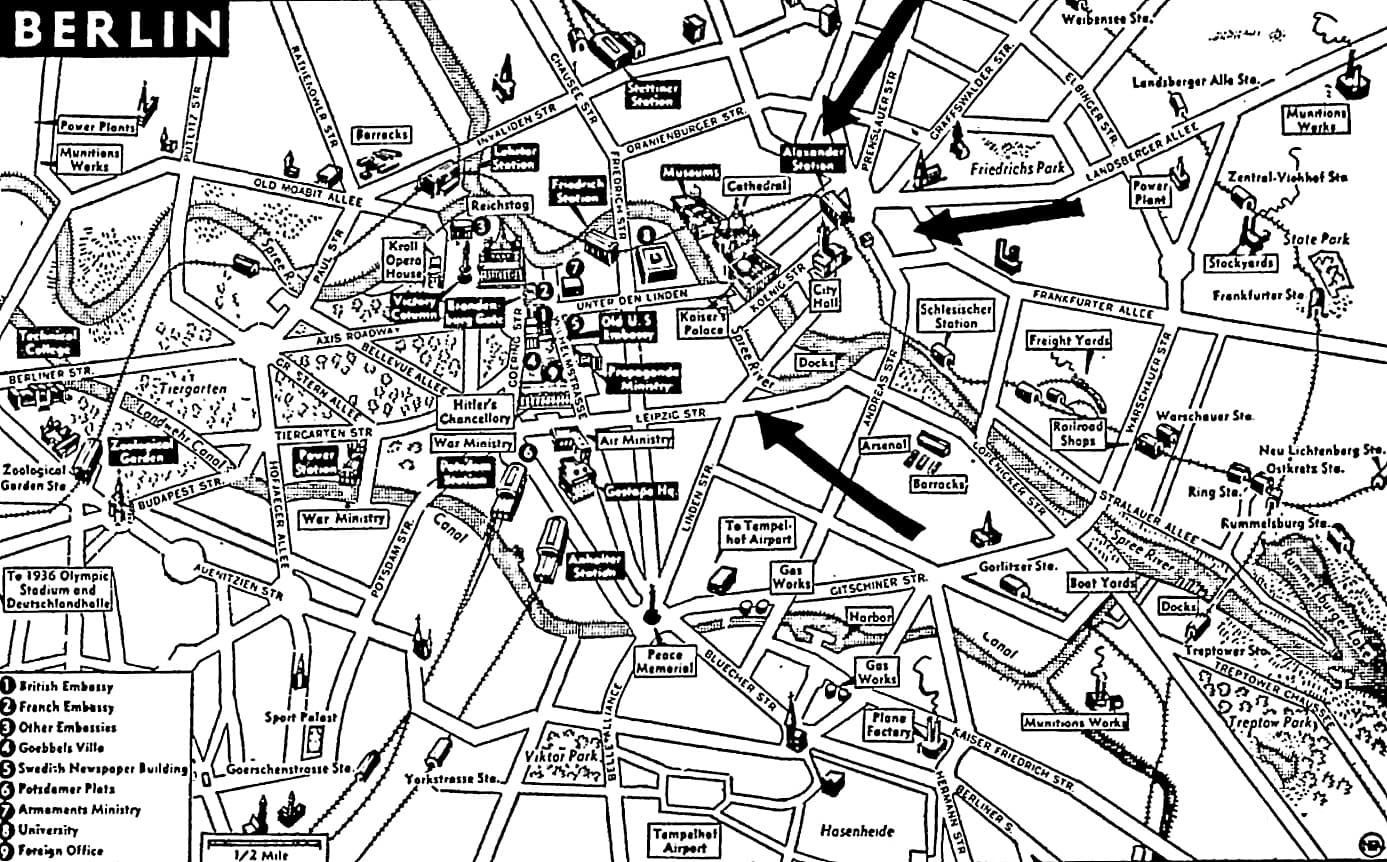ПРИКАЗ
Верховного Главнокомандующего
Командующему войсками 1-го Белорусского фронта
Маршалу Советского Союза ЖУКОВУ
Начальнику штаба фронта
Генерал-полковнику МАЛИНИНУ
Войска 1-го БЕЛОРУССКОГО фронта, перейдя в наступление с плацдармов на западном берегу ОДЕРА, при поддержке массированных ударов артиллерии и авиации прорвали сильно укреплённую, глубоко эшелонированную оборону немцев, прикрывавшую БЕРЛИН с востока, продвинулись вперёд от 60 до 100 километров, овладели городами ФРАНКФУРТ на ОДЕРЕ, ВАНДЛИЦ, ОРАНИЕНБУРГ, БИРКЕНВЕРДЕР, ГЕННИГСДОРФ, ПАНКОВ, ФРИДРИХСФЕЛЬДЕ, КАРЛСХОРСТ, КЕПЕНИК и ворвались в столицу Германии БЕРЛИН.
В боях при прорыве обороны немцев и наступлении на БЕРЛИН отличились войска генерал-полковника КУЗНЕЦОВА, генерал-полковника БЕРЗАРИНА, генерал-полковника ЧУЙКОВА, генерал-лейтенанта ПЕРХОРОВИЧА, 1-й польской армии генерал-лейтенанта ПОПЛАВСКОГО, генерал-полковника БЕЛОВА, генерал-полковника КОЛПАКЧИ, генерал-полковника ЦВЕТАЕВА, генерал-майора БУКШТЫНОВИЧА, генерал-майора КУЩЕВА, генерал-майора БЕЛЯВСКОГО, генерал-лейтенанта ЛУКЬЯНЧЕНКО, генерал-майора РОТКЕВИЧА, генерал-лейтенанта ПУЛКО-ДМИТРИЕВА, генерал-майора, ВЛАДИМИРСКОГО, генерал-майора ОРЛЕАНСКОГО, генерал-майора ПЕРЕВЕРТКИНА, генерал-лейтенанта КАЗАНКИНА, генерал-майора ФИРСОВА, генерал-лейтенанта ЖЕРЕБИНА, генерал-лейтенанта РОСЛОГО, генерал-лейтенанта ГЛАЗУНОВА, генерал-лейтенанта РЫЖОВА, генерал-майора артиллерии ХЕТАГУРОВА, генерал-лейтенанта ПОЗНЯКА, генерал-лейтенанта АНДРЕЕВА, генерал-майора АНАШКИНА, генерал-майора СИЯЗОВА, генерал-лейтенанта ХАЛЮЗИНА, генерал-майора ВЕРЖБИЦКОГО, генерал-майора БЕВЗЮКА, генерал-майора КЕНЕВИЧА, полковника СУРЖИЦА, полковника ЗАЙКОВСКОГО, полковника ШЕЙПАКА; артиллеристы генерал-полковника артиллерии КАЗАКОВА, генерал-лейтенанта артиллерии НАДЫСЕВА, генерал-майора артиллерии КОСЕНКО, генерал-лейтенанта артиллерии ПОЖАРСКОГО, генерал-майора артиллерии МОРОЗОВА, генерал-майора артиллерии МОДЗЕЛЕВСКОГО, генерал-майора артиллерии ЕГОРОВА, генерал-майора артиллерии ПЛАСКОВА, генерал - майора артиллерии ФРОЛОВА, генерал-лейтенанта артиллерии ИГНАТОВА, генерал-лейтенанта артиллерии РОЖАНОВИЧА, генерал-майора артиллерии ЛИХАЧЕВА, генерал-майора артиллерии ЗЕРНОВА, генерал-майора артиллерии ЗРАЖЕВСКОГО, генерал - майора артиллерии БОГДАНА, полковника МИХАЙЛОВА, генерал-майора артиллерии СЕРЕДИНА, полковника ПАСЬКО, полковника КОРЧАГИНА, полковника ПИСАРЕВА, полковника ЖИГАРЕВА, полковника КОБРИНА, полковника БЛОНСКОГО, полковника ВИКЕНТЪЕВА, полковника ЛЯШКО, генерал-майора артиллерии КЕРП, полковника СОКОЛОВА, майора ГОРКУНА, подполковника ДОРОЖКИНА, майора БАДАЕВА, подполковника СКВОРЦОВА, подполковника МИХАЙЛОВСКОГО; танкисты генерал-полковника танковых войск БОГДАНОВА, генерал-полковника танковых войск КАТУКОВА, генерал-лейтенанта РАДЗИЕВСКОГО, генерал-лейтенанта танковых войск ШАЛИНА, полковника АНИСИМОВА, генерал-майора танковых войск ВАЙНРУБА, полковника НИКОЛАЕВА, генерал-майора танковых войск КРЕТОВА, генерал-майора танковых войск НИКУЛИНА, генерал-майора танковых войск ВЕДЕНЕЕВА, генерал-лейтенанта танковых войск КРИВОШЕИНА, , генерал-майора танковых -войск ТЕЛЯКОВА, полковника БАБАДЖАНЯНА, генерал-майора ДРЕМОВА, генерал-лейтенанта танковых войск КИРИЧЕНКО, полковника ЮРЕНКОВА, полковника НАРУЦКОГО, полковника ЕРЕМЕЕВА, полковника БАЧАКОШВИЛИ; кавалеристы генерал-лейтенанта КОНСТАНТИНОВА; лётчики главного маршала авиации НОВИКОВА, главного маршала авиации ГОЛОВАНОВА, генерал-полковника авиации РУДЕНКО, генерал-лейтенанта авиации БРАЙКО, генерал-майора авиации КАРАВАЦКОГО, генерал-лейтенанта авиации САВИЦКОГО, генерал-майора авиации ДЗУСОВА, генерал-майора авиации СИДНЕВА, генерал-майора авиации ТОКАРЕВА, генерал-майора авиации КРУПСКОГО, полковника СУХОРЯБОВА, полковника БЕРКАЛЬ, полковника СТАЛИНА, генерал-майора авиации КОМАРОВА, подполковника НАКОНЕЧНИКОВА, полковника РАССКАЗОВА, полковника КАЛИНИНА, генерал-лейтенанта авиации БЕЛЕЦКОГО, генерал-майора авиации СКОК, генерал-майора авиации БОРИСЕНКО, полковника ТУРЫКИНА, генерал-лейтенанта авиации ТУПИКОВА, генерал-лейтенанта авиации СЧЕТЧИКОВА, генерал-лейтенанта авиации НЕСТЕРЦЕВА, генерал-майора авиации ЛЕБЕДЕВА, генерал-майора авиации КАРТАКОВА, генерал-майора авиации ГЛУЩЕНКО, генерал-майора авиации ЧЕМОДАНОВА, генерал-майора авиации НАБОКОВА, генерал-майора-авиации БАЛАШОВА, генерал-майора авиации ТИХОНОВА, генерал-майора авиации БЛИНОВА, генерал-майора авиации МЕНЬШИКОВА, генерал-майора авиации БРОВКО, генерал-майора авиации ШИРОКОГО, полковника ГОРЕВАЛОВА, полковника ЧУПИКОВА, полковника ГУСАРОВА; сапёры генерал-полковника инженерных войск ПРОШЛЯКОВА, генерал-майора инженерных войск ФУРСА, генерал-майора инженерных войск ТКАЧЕНКО, генерал-майора инженерных войск МАРЬИНА, генерал - майора инженерных войск БОРДЗИЛОВСКОГО, полковника КОВАЛЕВА, полковника БЕЛЬСКОГО, генерал-майора инженерных войск ХАРЧЕВИНА, генерал-майора инженерных войск ЯКОВЛЕВА, подполковника НЕДЗЕЛЬСКОГО, полковника МАСИКА, подполковника ЧИСТОВА, полковника ПРУССА, инженер-подполковника ЛЕСИНА; связисты генерал-лейтенанта войск связи МАКСИМЕНКО, полковника ФАЛИНА, полковника ЧЕРКАСОВА, генерал-майора войск связи АКИМОВА, полковника СОЛОВЬЕВА, генерал-майора войск связи ЛИТВИНЕНКО, подполковника ВИННИКА, полковника СМОЛИЙ, подполковника ЗАХАРОВА, подполковника государственной безопасности ВАКИША.
В ознаменование одержанной победы соединения и части, наиболее отличившиеся в боях при прорыве обороны немцев и наступлении на БЕРЛИН, представить к награждению орденами.
Сегодня, 23 апреля, в 21 час столица нашей Родины МОСКВА от имени Родины салютует доблестным войскам 1-го Белорусского фронта, в том числе 1-й. польской армии генерал-лейтенанта ПОПЛАВСКОГО, прорвавшимся к БЕРЛИНУ – двадцатью артиллерийскими залпами из двухсот двадцати четырёх орудий.
За отличные боевые действия ОБЯВЛЯЮ БЛАГОДАРНОСТЬ руководимым Вами войскам, участвовавшим в. боях при прорыве обороны немцев и-наступлении на БЕРЛИН.
Вечная слава героям, павшим в боях за свободу и независимость нашей Родины!
Смерть немецким захватчикам!
Верховный Главнокомандующий
Маршал Советского Союза И. СТАЛИН
23 апреля 1945 года. № 339.
